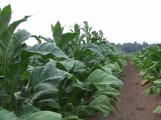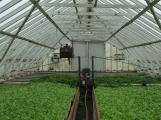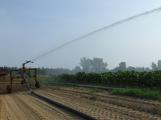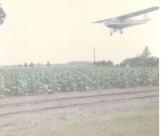1
Flue-Cured TobaccoAugust 2008
Bothwell, Ontario, Canada
 Credits:
Credits:Courtesy of Bothwell-Zone & District Historical Society
2
Flue-cured:Heat is carried though out the kiln using flue pipes to cure (yellow and dry) tobacco leaves. Although the methods have changed over the years the term "flue-cured" is still applied to this method of curing tobacco.
4
Shares:Absentee tobacco owners sharecropped their farm to others who would grow a crop of tobacco for a share of the profits. The usual percentage was 60/40 with the larger percentage for the share grower. Many farm owners started their tobacco careers as share growers.
5
GreenhouseMay 2008
Bothwell, Ontario, Canada
 Credits:
Credits:Courtesy of Bothwell-Zone & District Historical Society
6
Greenhouse:A greenhouse is a glass enclosure in which tobacco seedlings are grown. A walkway divides the greenhouse in to two beds- each side measuring 3 to 3.5 metres (ten to twelve feet) in width by twelve to sixty metres (forty to two hundred feet) long. Solar heat from the sun provides the warm temperature to grow the seedlings.
7
Muck:Muck is soil that is rich in decayed vegetation obtained from pre-historic marshes. Muck absorbs water readily and does not compact which allows the tobacco seedlings to establish an adequate roots system before transplanting into the fields.
9
Chemicals:DDT, Aldrin and several other chemicals were very effective in controlling insects that attacked young tobacco seedlings but were proven to be harmful to the environment. These are no longer used making way for other regulated chemicals.
10
Rights:An average farm had basic rights of 13.50 hectares (33 arecas) with some smaller or larger. Rights which were assigned to each individual farm were non-negotiable. In the 1980's rights could be sold and transferred to other farms. Rights by acreage were later changed to poundage produced. The quota system of rights or poundage is set each year by the Tobacco Marketing Board in accordance to market demand.
11
Jack Planter:A Jack planter is made of two compartments - one for water and the other for a tobacco plant. The end of the jack planter is tapered to aid pushing it into the ground. A trigger mechanism opens the tapered end slightly to release the tobacco plant and deposit a measure amount of water. Jack planters are operated by hand to replace any damaged or missing plant in the rows.
12
IrrigationJune 2008
Bothwell, Ontario, Canada
 Credits:
Credits:Courtesy of Bothwell-Zone & District Historical Society
13
Irrigation:Water is pumped through large diameter pipes to the fields by motor/tractor driven irrigation pumps from field ponds under high pressure. Individual rotating spray nozzles or high velocity guns spray water over the tobacco plants.
14
Tobacco Horn worm:The green caterpillar(larva) with five pairs of prolegs, a red horn and seven diagonal white stripes is 8.50 centimetres ( 3.5 inches) in length which develops into the Sphinx moth. The larva's colouration blends in with the tobacco leaves as it feeds leaving behind black droppings. It will burrow into the soil to pupate producing two generations a year.

